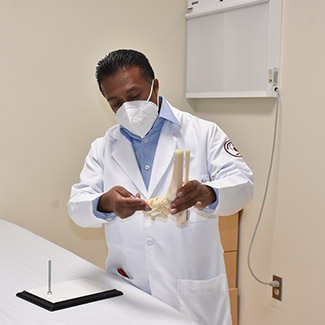What is clubfoot?
Treatment Options Within Shriners Hospital for Children
This time, we interviewed Dr. Gilberto Rios, who is part of the medical staff at Shriners Hospital, so he could discuss clubfoot deformity. Dr. Rios studied medicine at UNAM His specialty and subspecialty were completed at Shriners Hospital. He has dedicated his work to the treatment of orthopedic malformation, mainly the treatment of clubfoot with the Ponseti method.
What is clubfoot?
This infirmity is so frequent that, according to what is historically documented in medicine, it has existed since human beings exist. There are documented cases of the deformity since the time of Hippocrates. There are documents, graphics and vessels of pre-Hispanic cultures, such as the Teotihuacan culture, where it is mentioned, being considered, at the time, as signs of deity. There are drawings of children in European paintings with the title “boy with clubfoot” or “boot foot”, which is how it was previously known. This gives a notion of how frequent the condition is. Following developmental hip dysplasia, clubfoot is the second most common deformity in orthopedic care. It is estimated that 5 thousand children are born with this deformity in Mexico.
Risk Factors
It is an infirmity that cannot be prevented. Although there are some risk factors, such as fetal position before birth (Pelvic) and gemelar pregnancy, the theory about the amount of amniotic fluid in pregnancy (Oligohydramnios) being able to influence the occurrence, for example, the reality is that today we are not aware of what determines its presentation. Dr. Rios shares that this deformity is more frequent in boys than in girls. Currently, the child can be diagnosed as having this deformity with the help of a structural ultrasound. Diagnosis by this method is simple. Most of the time it is a pediatrician or gynecologist who makes the diagnosis, then telling parent that, at birth, the baby will need medical attention. There are studies showing that there is a higher incidence in Polynesians, at a ratio of 8 to 1 compared to Caucasians, and the reason for this prevalence is still unknown.
Treatment
Currently, the ideal treatment for clubfoot is conservative and uses the Ponseti method. It can be started from two weeks after the baby is born. It is not recommended that treatment begin in the first days after birth, much less in the hospital, since attachment between the family and the baby must take place first. “Taking home a baby wearing a cast can be difficult for the family, which is why we recommend having the baby home for a couple of weeks, or a month, and then starting treatment,” says Dr. Rios. The Ponseti method consists in placing casts that are changed weekly. After placing a certain number of casts - which will depend on the baby’s deformity - four to six casts may be required.
A small surgery called the Achilles tenetomy is later performed, as this is part of the method of treatment. Afterwards begins the maintenance phase, where the aim is to maintain the deformity’s correction with the use of a bar that has special boots placed on it. This phase of the treatment is the longest, for it reaches up to five years of age, and the parents are the main person responsible for carrying out and providing follow-up to the baby's treatment. In short, the Ponseti method consists of three phases:
- Placement of casts to correct the deformity
- Achilles tenotomy to lengthen the Achilles heel.
- Use of the bar with shoes until up to five years of age.
This method was instilled by the Spanish physician Ponseti, who studies the treatment of clubfoot and developed his own method of treatment. The risk of the clubfoot deformity returning is very high, regardless of the course of treatment. During the first year of age, the percentage of regression can be 60%, which decreases as the baby grows. From the age of 5, the percentage of regression is 8 to 10%. This is the reason why the bar is used at this age. Another reason is because at this age, all the bones of the foot have already ossified.
Council for Parents
“We would ask for patience. The treatment is very specific and requires the cast be placed specifically and punctually. This limits the number of patients that can be admitted. The hospital has a program where the patients are gradually accepted. For example, if this month 30 children are accepted, this children are going to use, on average, 6 casts to achieve a correction, and until that group is finished, no more patients are accepted, which allows the treatment to be correct, well monitored, adequate, and above all, to ensure the treatment’s success,” concludes Dr. Rios.

Keep In Touch
Join our mailing list to stay up to date on everything that's happening at Shriners Children's.
